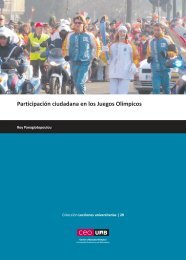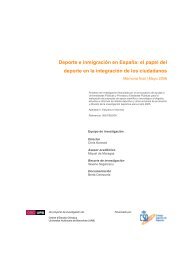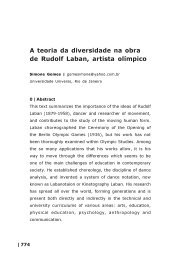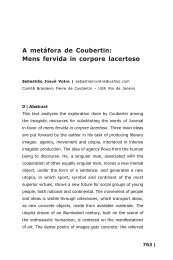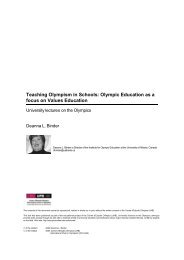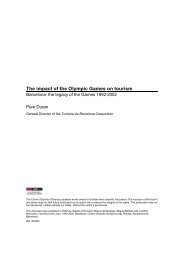The economic impact of the Barcelona Olympic Games, 1986-2004
The economic impact of the Barcelona Olympic Games, 1986-2004
The economic impact of the Barcelona Olympic Games, 1986-2004
You also want an ePaper? Increase the reach of your titles
YUMPU automatically turns print PDFs into web optimized ePapers that Google loves.
© 2005 Centre d’Estudis Olímpics UAB<br />
Ferran Brunet - Economic <strong>impact</strong> <strong>of</strong> <strong>the</strong> <strong>Barcelona</strong> <strong>Olympic</strong> <strong>Games</strong><br />
<strong>The</strong> model is based on maximisation <strong>of</strong> investment, attraction <strong>of</strong> fur<strong>the</strong>r investment and temporal<br />
concentration. Given <strong>the</strong> scope <strong>of</strong> urban transformation sought, continued investment is essential. This<br />
has occurred in <strong>the</strong> case <strong>of</strong> <strong>Barcelona</strong> (Table 3).<br />
<strong>Barcelona</strong> has been highly successful in harnessing <strong>the</strong> <strong>Olympic</strong> impetus and benefiting from <strong>the</strong><br />
investment made, and this had facilitated change. <strong>The</strong> resources allocated to urban infrastructure led to<br />
temporary employment in <strong>the</strong> necessary construction work, followed by permanent employment in<br />
operation <strong>of</strong> this infrastructure. Both led to increased <strong>economic</strong> activity, although not all <strong>of</strong> it was<br />
concentrated in <strong>the</strong> city itself. <strong>The</strong> capital invested and <strong>the</strong> increased <strong>economic</strong> activity led to increased<br />
wealth, wellbeing, and social cohesion and made <strong>the</strong> city more attractive.<br />
Comparison <strong>of</strong> <strong>Olympic</strong> <strong>impact</strong>s, 1964-2008: <strong>Barcelona</strong> as an exception<br />
A database has been prepared to compare <strong>the</strong> <strong>Olympic</strong> <strong>impact</strong> <strong>of</strong> various host cities in terms <strong>of</strong><br />
organisation, investment and resulting <strong>economic</strong> <strong>impact</strong> (Figure 9). 4<br />
<strong>Barcelona</strong>’s performance again stands out. <strong>The</strong> <strong>Olympic</strong> investments and <strong>the</strong>ir <strong>economic</strong> <strong>impact</strong> are<br />
without parallel in <strong>the</strong> o<strong>the</strong>r host cities . Only Tokyo reached half <strong>the</strong> volume <strong>of</strong> <strong>the</strong> investment generated in<br />
<strong>Barcelona</strong>. Investment was also significant in Seoul; however, <strong>Olympic</strong> investments in Atlanta and Sydney<br />
were very limited. <strong>The</strong> projections for A<strong>the</strong>ns and Beijing include major investment and <strong>impact</strong>, more along<br />
<strong>the</strong> lines <strong>of</strong> <strong>Barcelona</strong>.<br />
III. <strong>2004</strong>-2010: Strategy and perspectives<br />
<strong>The</strong> <strong>Olympic</strong> Legacy and continued investment as driving forces for <strong>Barcelona</strong>’s new strategic<br />
position<br />
Now in <strong>2004</strong> we can see that <strong>the</strong> investment made between <strong>1986</strong> and 1992 were <strong>the</strong> key to <strong>the</strong> city’s<br />
urban transformation and its improved strategic positioning.<br />
Investment in infrastructure and urban transformation, <strong>1986</strong>-2010<br />
<strong>The</strong> investments are <strong>the</strong> key element within <strong>the</strong> <strong>economic</strong> resources mobilised by <strong>Barcelona</strong>’92, and were<br />
crucial in <strong>the</strong> <strong>economic</strong> <strong>impact</strong> <strong>of</strong> <strong>the</strong> <strong>Games</strong>, <strong>the</strong> city’s transformation and <strong>the</strong> subsequent increase in<br />
<strong>economic</strong> activity, income and wellbeing.<br />
<strong>The</strong> investments explain a great part <strong>of</strong> <strong>Barcelona</strong>’92’s exemplary success and were notable both in terms<br />
<strong>of</strong> <strong>the</strong> quality <strong>of</strong> <strong>the</strong> infrastructure and scale <strong>of</strong> funding (10,660 million Euro). <strong>The</strong>y constitute <strong>the</strong> <strong>Olympic</strong><br />
Legacy which underpinned much <strong>of</strong> <strong>Barcelona</strong>’s <strong>economic</strong> and social boom in <strong>the</strong> 1990s.<br />
Not only were <strong>the</strong> investments central to <strong>the</strong> original <strong>Olympic</strong> impetus, <strong>the</strong>y were also important in<br />
completing <strong>the</strong> <strong>impact</strong> and enabling continuation <strong>of</strong> <strong>the</strong> urban transformation and strategic streng<strong>the</strong>ning<br />
process. For this reason, <strong>the</strong> investments made post-1992 are also set out in Table 5. Two central axes<br />
served to focus urban transformation in <strong>the</strong> post-<strong>Olympic</strong> period:<br />
10




